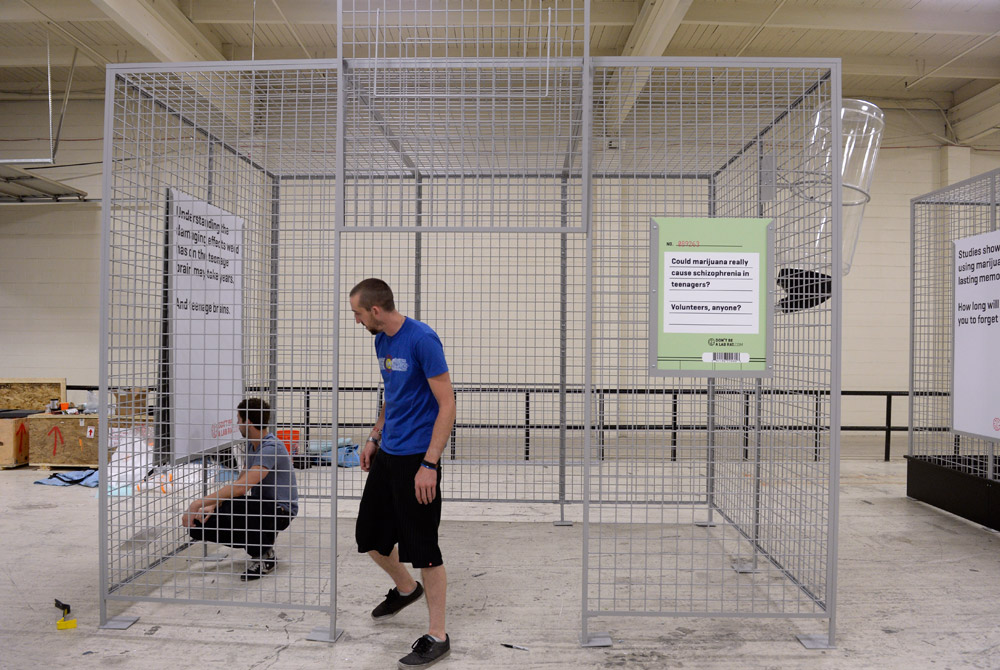It’s not just those in the cannabis community who are feeling that erecting human-sized rat cages with massive water bottles attached was a poor choice of spending state money. Colorado’s $2 million “Don’t Be a Lab Rat” campaign aimed at preventing teen marijuana use raised eyebrows everywhere as soon as it was announced. In fact, the Boulder Valley School District refused the offer to house cages at any of their campuses. The City of Boulder followed suit not long after by announcing it too would not allow the Lab Rat campaign to place any of the larger-than-life props on its property.
But why? Nobody wants kids to do drugs, legal or otherwise, and an effective campaign against teen use of marijuana should be a component in the states where it is being legalized. Proponents of legalization especially do not want acceptance of adult use of cannabis to translate into an increase in underage users. In order for that to be avoided, kids need to be educated on the potential punishments and consequences they face if they head down that path before it’s legal for them.
Other ad campaigns: A thoughtful look at legalization — what happened to “Just Say No”?
I can see that the campaign was not anticipating coming off as degrading; it had aimed to be thought-provoking and a conversation starter. The jury is still out on pot’s potential consequences for teen users, and that is just the sentiment the campaign creators hoped to elicit. Large posters displayed on and in the cages warn about marijuana’s potential to affect short-term memory and inform passersby that studies have shown cannabis use might cause schizophrenia.
But if one were so inclined to visit DontBeALabRat.com and follow a link to one of the articles from which their schizophrenia claims originate (“A genetic link may exist between cannabis use and schizophrenia”), well, some of the information provided is quite different. From the Reuters article referenced:
The researchers found that people genetically predisposed to schizophrenia were more likely to use cannabis.
Catch that? It says that people with the pre-existing genetic makeup to have schizophrenia are more likely to use marijuana — not the other way around. It’s like someone telling you that food choices affect your weight and in the same breath providing you information that says being overweight is an inherited condition. It’s confusing and it’s misleading.
Parenting: 10 ways to keep your stash away from kids

I get that the campaign is trying to put a little fear into kids by insinuating that their casual experimentation and use of marijuana will be the statistical data of the future. But it has to be said, scare tactics do not work. Many studies, whose findings have been compiled for the non-profit group Prevention First, have even presented evidence that “fear appeals may cause an audience to tune out a message or not believe it.”
Fear mongering is not completely without effects as it has been shown to change a user’s attitude about the substance or behavior in question. Still, while the way someone feels about a behavior may change due to being scared — that does not mean that they cease using the substance or partaking in the behavior, just that they feel worse about it.
The oversized cages can also be interpreted as a direct visual cue that marijuana use equals time behind bars. It may not have been the intention of the creators but it’s hard to imagine those who conceived the campaign were unaware of the similarities between the cages and jail cells. It sure is hard to ignore when looking at someone standing in one of the pens.
One other thing worth noting is that while surveys of Colorado teens between 2011 and 2013 show fewer teens perceived marijuana as risky, there hasn’t been a corresponding increase in use. Ever heard the phrase, “if it ain’t broke, don’t fix it?” This appears to be a textbook example.
A better use of the $2 million would have been another campaign. A mass appeal to stress to marijuana consumers their obligation to keep their stash properly secured. Because while the slight statistical decrease of teen marijuana use in Colorado is encouraging, the opposite is true of the increase in the number of pediatric emergency room visits where marijuana is the catalyst.
Just sayin’.
Colorado’s “Lab Rat” Experiment:
A special report from The Cannabist
We don’t want the cages in the People’s Republic: Boulder won’t display “Lab Rat” cage for Colorado teen campaign
Social-media commentary: When Cards Against Humanity is used to make a political statement about the “Lab Rat” campaign
Making a mark: Giant cage gets noticed at Denver skate park — and vandalized
Editorial: Youth education campaign gets points for honesty, but cages a bit much
Poll: Will the “Lab Rat” campaign help curb youth pot use?
